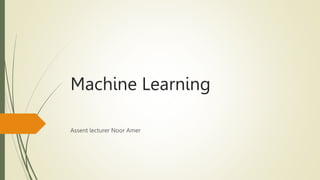
machine learning basic-1.pptx
- 1. Machine Learning Assent lecturer Noor Amer
- 2. What is Machine Learning Question Suppose your email program watches which emails you do or do not mark as spam, and based on that learns how to better filter spam. What is its experience E, task T, and performance P? ● Classifying emails as spam or not spam ● Watching you label emails as spam or not spam ● The number of emails correctly classified as spam/not spam 2
- 3. Classification From data to discrete classes 3 Weather Prediction
- 4. Regression Predicting a numeric value 4 Stock Market
- 5. Clustering discovering structure in data 5 Group similar things
- 6. 6
- 7. Machine Learning Definition We are drowning in information and starving for knowledge. — John Naisbitt We are entering the era of big data. For example, there are about 1 trillion web pages; one hour of video is uploaded to YouTube every second, Walmart handles more than 1M transactions per hour and has databases containing more than 2.5 petabytes (2.5 × 1015) of information (Cukier 2010); and so on. This deluge of data calls for automated methods of data analysis, which is what machine learning provides. Machine learning is defined as a set of methods that can automatically detect patterns in data, and then use the uncovered patterns to predict future data, or to perform other kinds of decision making under uncertainty (such as planning how to collect more data!). 7
- 8. The definition of Machine Learning only addresses the concept of data and model and has nothing to do with “learning”? The name itself reflects that the technique analyzes the data and finds the model by itself rather than having a human do it. we call it “learning” because the process resembles being trained with the data to solve the problem of finding a model. Therefore, the data that Machine Learning uses in the modeling process is called “training” data. Machine Learning Definition
- 10. Type of Input dataset These input data used to build the model are usually divided in multiple datasets. In particular, three data sets are commonly used in different stages of the creation of the model: training, validation and test sets. 1. Training data: - The first subset is known as the training data - it’s a portion of actual dataset that is fed into the machine learning model to discover and learn patterns. In this way, it trains the model. Training data is typically larger than testing data. This is because need to feed the model with as much data as possible to find and learn meaningful patterns. Once data from datasets are fed to a machine learning algorithm, it learns patterns from the data and makes decisions
- 11. Type of Input dataset Testing data:- Once machine learning model is built (with training data), needed unseen data to test model. This data is called testing data, and can use it to evaluate the performance and progress of algorithms’ training and adjust or optimize it for improved results. Testing data has two main criteria. It should: Represent the actual dataset Be large enough to generate meaningful predictions Validation data sets:- The sample of data used to provide an unbiased evaluation of a model fit on the training dataset while tuning model hyperparameters. The evaluation becomes more biased as skill on the validation dataset is incorporated into the model configuration.
- 12. The procedure, using a three-way data split is then (i) Divide the available data into training, validation, and test data (ii) Select the architecture and training parameters (iii) Train the model using the training set (iv) Evaluate the model using the validation set (v) Repeat steps (ii)–(iv) using different architectures and training parameters (vii) Assess the model using the test set
- 13. Divide the Data Select the algorithms Train the model Evaluate the model Assess the model
- 14. General notations and concepts x(i) to denote the “input” variables (living area in this example), also called input features, and y(i) to denote the “output” or target variable that we are trying to predict (for example price of the house). A pair (x, y) is called a training example, and the dataset that we’ll be using to learn—a list of m training examples {(x(i), y(i)); i = 1, . . . ,m}—is called a training set. To describe the supervised learning problem slightly more formally, our goal is, given a training set, to learn a function h : X →Y so that h(x) is a “good” predictor for the corresponding value of y. For historical reasons, this function h is called a hypothesis. 14
- 15. General notations and concepts contd. When the target variable that we’re trying to predict is continuous, such as in our housing example, we call the learning problem a regression problem. When y can take on only a small number of discrete values (such as if, given the living area, we wanted to predict if a dwelling is a house or an apartment, say), we call it a classification problem. 15